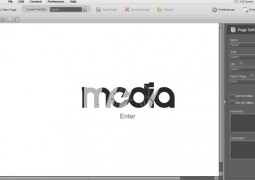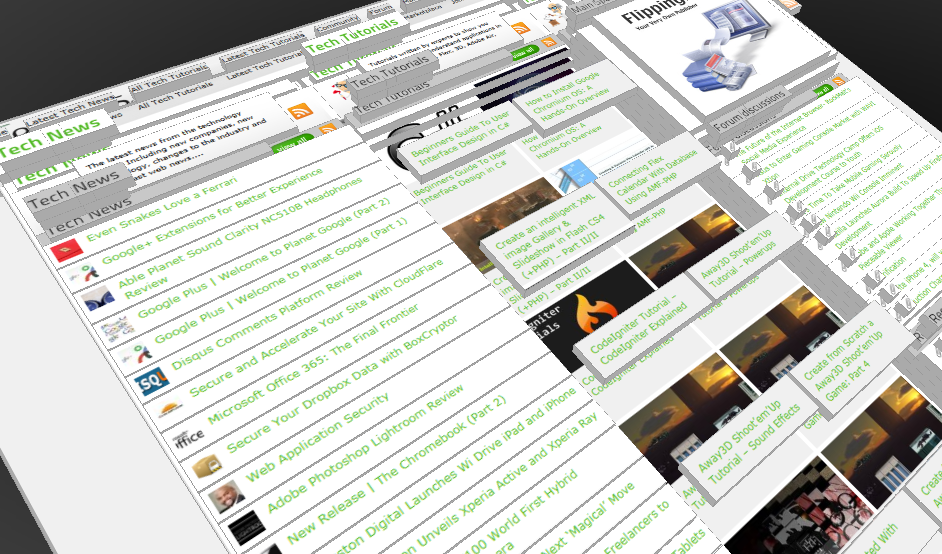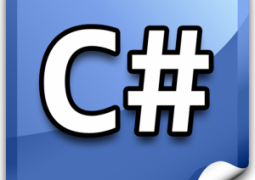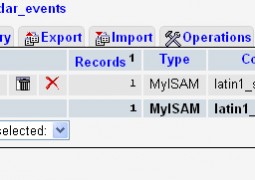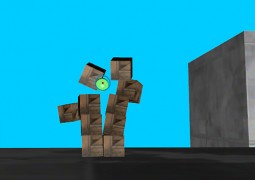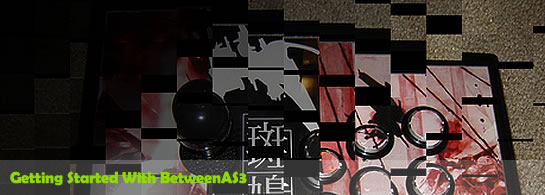How to build a Flash Actionscript 3.0 Videoplayer
by 30 July, 2008 11:21 pm196
Today we explain you how to create a videoplayer with some basic features like this one.
These are: – Play/Pause – Stop – Preloading – Scrubbing – Volume handling There will be another tutorial, which will extend this player. So be sure to check it out.
Requirements
Adobe Flash CS3
Source Files
Constants
As always, we begin with setting the constants. The BUFFER_TIME constant stores the time to buffer for the video in seconds. This one will later be assigned to the netstream object
const BUFFER_TIME:Number = 8;
DEFAULT_VOLUME holds the start volume when the player starts
const DEFAULT_VOLUME:Number = 0.6;
Our player has a timer, that updates all the visual parts. We store the update delay in milliseconds in a constant.
const DISPLAY_TIMER_UPDATE_DELAY:int = 10;
To make the video a bit smoother, we can the the Video.smoothing variable to true. This may slow down old computers. If you want to deactivate the smoothing on runtime, just open the html file in the zip file, right click on the video player and choose low for the quality. This way the smoothing will automatically be deactivated by the flash player.
const SMOOTHING:Boolean = true;
Variables
Let’s move on with the variables. We need to know, if the flv has been loaded when clicking the play button in order to load it or just play the video.
var bolLoaded:Boolean = false;
For the timer function we need to know, if we’re currently scrubbing the volume or the progress bar.
var bolVolumeScrub:Boolean = false; var bolProgressScrub:Boolean = false;
Our player has also a mute/unmute button. So, we need to store the last used volume. Like this when you click on unmute, the scrubber will jump back to it’s previous position as the volume does. This value is always greater than zero. We asign the value from DEFAULT_VOLUME.
var intLastVolume:Number = DEFAULT_VOLUME;
Then we need to have a net connection object for net stream and of course also a net stream object.
var ncConnection:NetConnection; var nsStream:NetStream;
To store the received meta data from the flv file, we create an object
var objInfo:Object;
You can change your url to the flv file here. We just set it to the sample movie that’s in the same folder as the swf.
var strSource:String = "hancock-tsr2_h480p.flv";
And last of all, we create a timer object for updating the stuff from the player.
var tmrDisplay:Timer;
Functions
Now we need to initialize our player. First of all, we hide the unmute and pause button. Then we set the width of the progress and preload fill to 1.Our next step is adding a global eventlistener when the mouse button is released and adding event listeners to all buttons. Then we create ourtimer object for
updating all parts of the player and add the event listener. Next we create a new net connection, add the event listener and connect it to null because we don’t have a media server. The net stream object needs the net connection for initializing. Once we have our net stream object ready, we add the event listener, set the client property to this for handling the meta data and set buffer time to the value from the constant BUFFER_TIME. Then we attach the net stream to the video object on the stage and set the smoothing property to the value from the constant SMOOTHING. Last of all we set the default volume to the value from the constant DEFAULT_VOLUME. Note that only values from zero to one are allowed.
function initVideoPlayer():void {
mcVideoControls.btnUnmute.visible = false;
mcVideoControls.btnPause.visible = false;
mcVideoControls.mcProgressFill.mcFillRed.width = 1;
mcVideoControls.mcProgressFill.mcFillGrey.width = 1;
stage.addEventListener( MouseEvent.MOUSE_UP, mouseReleased);
mcVideoControls.btnPause.addEventListener(MouseEvent.CLICK, pauseClicked);
mcVideoControls.btnPlay.addEventListener(MouseEvent.CLICK, playClicked);
mcVideoControls.btnStop.addEventListener(MouseEvent.CLICK, stopClicked);
mcVideoControls.btnMute.addEventListener(MouseEvent.CLICK, muteClicked);
mcVideoControls.btnUnmute.addEventListener(MouseEvent.CLICK, unmuteClicked);
mcVideoControls.mcVolumeScrubber.btnVolumeScrubber.addEventListener(MouseEvent.MOUSE_DOWN, volumeScrubberClicked);
mcVideoControls.mcProgressScrubber.btnProgressScrubber.addEventListener(MouseEvent.MOUSE_DOWN, progressScrubberClicked);
tmrDisplay = new Timer(DISPLAY_TIMER_UPDATE_DELAY);
tmrDisplay.addEventListener(TimerEvent.TIMER, updateDisplay);
ncConnection = new NetConnection();
ncConnection.addEventListener(NetStatusEvent.NET_STATUS, netStatusHandler);
ncConnection.connect(null);
nsStream = new NetStream(ncConnection);
nsStream.addEventListener(NetStatusEvent.NET_STATUS, netStatusHandler);
nsStream.client = this;
nsStream.bufferTime = BUFFER_TIME;
vidDisplay.attachNetStream(nsStream);
vidDisplay.smoothing = SMOOTHING;
mcVideoControls.mcVolumeScrubber.x = (53 * DEFAULT_VOLUME) + 341;
mcVideoControls.mcVolumeFill.mcFillRed.width = mcVideoControls.mcVolumeScrubber.x - 394 + 53;
setVolume(DEFAULT_VOLUME);
}
The most important part is now done. We’ve set all variables and added all event listeners. We’re now going to go through all button event listeners. When the user hit’s the play button, we need to check, if the flv download has already begun. If that’s the case, we resume the playback with the NetStream.resume() function. If not, we call the play() function and add the source to the flv file as the parameter.
Then we show the video display object that’s on the stage. And finally we switch the pause/play visibility.
function playClicked(e:MouseEvent):void {
if(!bolLoaded) {
nsStream.play(strSource);
bolLoaded = true;
} else {
nsStream.resume();
}
vidDisplay.visible = true;
mcVideoControls.btnPause.visible = true;
mcVideoControls.btnPlay.visible = false;
}
The pause button only calls the pause() function from the net stream object and switches the pause/play visibility.
function pauseClicked(e:MouseEvent):void {
nsStream.pause();
mcVideoControls.btnPause.visible = false;
mcVideoControls.btnPlay.visible = true;
}
When the user click’s the play button, the stopVideoPlayer() function will be called. We’ll explain this function below.
function stopClicked(e:MouseEvent):void {
stopVideoPlayer();
}
The mute button sets the volume to zero and updates the volume scrubber and fill position/width.
function muteClicked(e:MouseEvent):void {
setVolume(0);
mcVideoControls.mcVolumeScrubber.x = 341;
mcVideoControls.mcVolumeFill.mcFillRed.width = 1;
}
The unmute button sets the volume to the last used volume and updates the volume scrubber and fill position/width.
function unmuteClicked(e:MouseEvent):void {
setVolume(intLastVolume);
mcVideoControls.mcVolumeScrubber.x = (53 * intLastVolume) + 341;
mcVideoControls.mcVolumeFill.mcFillRed.width = mcVideoControls.mcVolumeScrubber.x - 394 + 53;
}
When the volume scrubber is clicked, the scrub flag will be set to true. Then we start dragging it withing the boundings that are described as a rectangle.
Exactly the same goes for the progress scrubber except that we’re setting another flag variable and bounding.
function volumeScrubberClicked(e:MouseEvent):void {
bolVolumeScrub = true;
mcVideoControls.mcVolumeScrubber.startDrag(false, new Rectangle(341, 19, 53, 0));
}
function progressScrubberClicked(e:MouseEvent):void {
bolProgressScrub = true;
mcVideoControls.mcProgressScrubber.startDrag(false, new Rectangle(0, 2, 432, 0));
}
Last of all, we have our mouseReleased() handler. This function is needed for knowing, when the user stops the scrubbing. First, we set the progress/volume scrub flag to false. Then we stop all dragging actions and update the width of the progress/volume fill. And if the volume is greater than zero, we store it in the variable intLastVolume.
function mouseReleased(e:MouseEvent):void {
bolVolumeScrub = false;
bolProgressScrub = false;
mcVideoControls.mcProgressScrubber.stopDrag();
mcVideoControls.mcVolumeScrubber.stopDrag();
mcVideoControls.mcProgressFill.mcFillRed.width = mcVideoControls.mcProgressScrubber.x + 5;
mcVideoControls.mcVolumeFill.mcFillRed.width = mcVideoControls.mcVolumeScrubber.x - 394 + 53;
if((mcVideoControls.mcVolumeScrubber.x - 341) / 53 > 0)
intLastVolume = (mcVideoControls.mcVolumeScrubber.x - 341) / 53;
}
The updateDisplay() function will be called by the timer object 100 times a second. If you want, you can decrease this value by increasing the value from the constant DISPLAY_TIMER_UPDATE_DELAY.
First of all, we check if the user is scrubbing on the progress bar. If that’s the case, we seek in the video. If not, we just update the position of the scrubber according to the current time.
Then we set the time and duration label. We format the values with the function formatTime() which we explain later.
Now we update the width from the progress bar. The grey one displays the loading progress while the red one shows the progress from the video.
Last of all we update the volume and the red fill width when the user is scrubbing.
function updateDisplay(e:TimerEvent):void {
if(bolProgressScrub)
nsStream.seek(Math.round(mcVideoControls.mcProgressScrubber.x * objInfo.duration / 432))
else
mcVideoControls.mcProgressScrubber.x = nsStream.time * 432 / objInfo.duration;
mcVideoControls.lblTimeDuration.htmlText = "" + formatTime(nsStream.time) + " / " + formatTime(objInfo.duration);
mcVideoControls.mcProgressFill.mcFillRed.width = mcVideoControls.mcProgressScrubber.x + 5;
mcVideoControls.mcProgressFill.mcFillGrey.width = nsStream.bytesLoaded * 438 / nsStream.bytesTotal;
if(bolVolumeScrub) {
setVolume((mcVideoControls.mcVolumeScrubber.x - 341) / 53);
mcVideoControls.mcVolumeFill.mcFillRed.width = mcVideoControls.mcVolumeScrubber.x - 394 + 53;
}
}
The onMetaDataFunction will be called as soon as the net stream object gets the meta stuff from the flv file. We store these informations in a object. Now can start the timer object because we have all the necessary data.
function onMetaData(info:Object):void {
objInfo = info;
tmrDisplay.start();
}
Once a net status event will be fired, the netStatusHandler() function will be called. The event holds the info code of the event type. We only need to handle NetStream.Play.StreamNotFound in case the stream is not found and NetStream.Play.Stop to know, when the video reached its end to stop the player with the stopVideoPlayer() function.
function netStatusHandler(event:NetStatusEvent):void {
switch (event.info.code) {
case "NetStream.Play.StreamNotFound":
trace("Stream not found: " + strSource);
break;
case "NetStream.Play.Stop":
stopVideoPlayer();
break;
}
}
There are 2 ways to stop the playback: One is clicking the stop button, the other is reaching the end of the video. That’s the reason why we’ve put this in a function. First we pause the netstream and set the playback position to zero. In order to clear the display where the last frame of the video will be shown we need to set the visibility to false. We can’t use the Video.clear() function since it has a bug. But this one has already been reported to adobe. This workaround works fine. Finlay we switch the play/button visibility.
function stopVideoPlayer():void {
nsStream.pause();
nsStream.seek(0);
vidDisplay.visible = false;
mcVideoControls.btnPause.visible = false;
mcVideoControls.btnPlay.visible = true;
}
To set the volume of the video we use the setVolume() function. First we create a soundtransform object with the value from the parameter. Then we assign this object to nsStream.soundTransform. And we hide or show the mute and unmute according to the volume. If it’s greater than zero, we show the mute button and vice versa.
function setVolume(intVolume:Number = 0):void {
var sndTransform = new SoundTransform(intVolume);
nsStream.soundTransform = sndTransform;
if(intVolume > 0) {
mcVideoControls.btnMute.visible = true;
mcVideoControls.btnUnmute.visible = false;
} else {
mcVideoControls.btnMute.visible = false;
mcVideoControls.btnUnmute.visible = true;
}
}
The last function formatTime() is used to format the seconds to the format mm:ss.
function formatTime(t:int):String {
var s:int = Math.round(t);
var m:int = 0;
if (s > 0) {
while (s > 59) {
m++;
s -= 60;
}
return String((m < 10 ? "0" : "") + m + ":" + (s < 10 ? "0" : "") + s);
} else {
return "00:00";
}
}
Call init function
The only thing left to do is calling the init function for the player.
initVideoPlayer();
We hope you liked this tutorial. If you have any question don’t hesitate to ask. Also we’ve already mentioned be sure to check back for the next part that will be coming soon.
Full code with comments
// ##########################
// ############# CONSTANTS
// ##########################
// time to buffer for the video in sec.
const BUFFER_TIME:Number = 8;
// start volume when initializing player
const DEFAULT_VOLUME:Number = 0.6;
// update delay in milliseconds.
const DISPLAY_TIMER_UPDATE_DELAY:int = 10;
// smoothing for video. may slow down old computers
const SMOOTHING:Boolean = true;
// ##########################
// ############# VARIABLES
// ##########################
// flag for knowing if flv has been loaded
var bolLoaded:Boolean = false;
// flag for volume scrubbing
var bolVolumeScrub:Boolean = false;
// flag for progress scrubbing
var bolProgressScrub:Boolean = false;
// holds the last used volume, but never 0
var intLastVolume:Number = DEFAULT_VOLUME;
// net connection object for net stream
var ncConnection:NetConnection;
// net stream object
var nsStream:NetStream;
// object holds all meta data
var objInfo:Object;
// url to flv file
var strSource:String = "hancock-tsr2_h480p.flv";
// timer for updating player (progress, volume...)
var tmrDisplay:Timer;
// ##########################
// ############# FUNCTIONS
// ##########################
// sets up the player
function initVideoPlayer():void {
// hide buttons
mcVideoControls.btnUnmute.visible = false;
mcVideoControls.btnPause.visible = false;
// set the progress/preload fill width to 1
mcVideoControls.mcProgressFill.mcFillRed.width = 1;
mcVideoControls.mcProgressFill.mcFillGrey.width = 1;
// add global event listener when mouse is released
stage.addEventListener( MouseEvent.MOUSE_UP, mouseReleased);
// add event listeners to all buttons
mcVideoControls.btnPause.addEventListener(MouseEvent.CLICK, pauseClicked);
mcVideoControls.btnPlay.addEventListener(MouseEvent.CLICK, playClicked);
mcVideoControls.btnStop.addEventListener(MouseEvent.CLICK, stopClicked);
mcVideoControls.btnMute.addEventListener(MouseEvent.CLICK, muteClicked);
mcVideoControls.btnUnmute.addEventListener(MouseEvent.CLICK, unmuteClicked);
mcVideoControls.mcVolumeScrubber.btnVolumeScrubber.addEventListener(MouseEvent.MOUSE_DOWN, volumeScrubberClicked);
mcVideoControls.mcProgressScrubber.btnProgressScrubber.addEventListener(MouseEvent.MOUSE_DOWN, progressScrubberClicked);
// create timer for updating all visual parts of player and add
// event listener
tmrDisplay = new Timer(DISPLAY_TIMER_UPDATE_DELAY);
tmrDisplay.addEventListener(TimerEvent.TIMER, updateDisplay);
// create a new net connection, add event listener and connect
// to null because we don't have a media server
ncConnection = new NetConnection();
ncConnection.addEventListener(NetStatusEvent.NET_STATUS, netStatusHandler);
ncConnection.connect(null);
// create a new netstream with the net connection, add event
// listener, set client to this for handling meta data and
// set the buffer time to the value from the constant
nsStream = new NetStream(ncConnection);
nsStream.addEventListener(NetStatusEvent.NET_STATUS, netStatusHandler);
nsStream.client = this;
nsStream.bufferTime = BUFFER_TIME;
// attach net stream to video object on the stage
vidDisplay.attachNetStream(nsStream);
// set the smoothing value from the constant
vidDisplay.smoothing = SMOOTHING;
// set default volume
mcVideoControls.mcVolumeScrubber.x = (52 * DEFAULT_VOLUME) + 341;
mcVideoControls.mcVolumeFill.mcFillRed.width = mcVideoControls.mcVolumeScrubber.x - 394 + 52;
setVolume(DEFAULT_VOLUME);
}
function playClicked(e:MouseEvent):void {
// check's, if the flv has already begun
// to download. if so, resume playback, else
// load the file
if(!bolLoaded) {
nsStream.play(strSource);
bolLoaded = true;
}
else{
nsStream.resume();
}
// show video display
vidDisplay.visible = true;
// switch play/pause visibility
mcVideoControls.btnPause.visible = true;
mcVideoControls.btnPlay.visible = false;
}
function pauseClicked(e:MouseEvent):void {
// pause video
nsStream.pause();
// switch play/pause visibility
mcVideoControls.btnPause.visible = false;
mcVideoControls.btnPlay.visible = true;
}
function stopClicked(e:MouseEvent):void {
// calls stop function
stopVideoPlayer();
}
function muteClicked(e:MouseEvent):void {
// set volume to 0
setVolume(0);
// update scrubber and fill position/width
mcVideoControls.mcVolumeScrubber.x = 341;
mcVideoControls.mcVolumeFill.mcFillRed.width = 1;
}
function unmuteClicked(e:MouseEvent):void {
// set volume to last used value
setVolume(intLastVolume);
// update scrubber and fill position/width
mcVideoControls.mcVolumeScrubber.x = (53 * intLastVolume) + 341;
mcVideoControls.mcVolumeFill.mcFillRed.width = mcVideoControls.mcVolumeScrubber.x - 394 + 53;
}
function volumeScrubberClicked(e:MouseEvent):void {
// set volume scrub flag to true
bolVolumeScrub = true;
// start drag
mcVideoControls.mcVolumeScrubber.startDrag(false, new Rectangle(341, 19, 53, 0));
}
function progressScrubberClicked(e:MouseEvent):void {
// set progress scrub flag to true
bolProgressScrub = true;
// start drag
mcVideoControls.mcProgressScrubber.startDrag(false, new Rectangle(0, 2, 432, 0));
}
function mouseReleased(e:MouseEvent):void {
// set progress/volume scrub to false
bolVolumeScrub = false;
bolProgressScrub = false;
// stop all dragging actions
mcVideoControls.mcProgressScrubber.stopDrag();
mcVideoControls.mcVolumeScrubber.stopDrag();
// update progress/volume fill
mcVideoControls.mcProgressFill.mcFillRed.width = mcVideoControls.mcProgressScrubber.x + 5;
mcVideoControls.mcVolumeFill.mcFillRed.width = mcVideoControls.mcVolumeScrubber.x - 394 + 53;
// save the volume if it's greater than zero
if((mcVideoControls.mcVolumeScrubber.x - 341) / 53 > 0)
intLastVolume = (mcVideoControls.mcVolumeScrubber.x - 341) / 53;
}
function updateDisplay(e:TimerEvent):void {
// checks, if user is scrubbing. if so, seek in the video
// if not, just update the position of the scrubber according
// to the current time
if(bolProgressScrub)
nsStream.seek(Math.round(mcVideoControls.mcProgressScrubber.x * objInfo.duration / 432))
else
mcVideoControls.mcProgressScrubber.x = nsStream.time * 432 / objInfo.duration;
// set time and duration label
mcVideoControls.lblTimeDuration.htmlText = "" + formatTime(nsStream.time) + " / " + formatTime(objInfo.duration);
// update the width from the progress bar. the grey one displays
// the loading progress
mcVideoControls.mcProgressFill.mcFillRed.width = mcVideoControls.mcProgressScrubber.x + 5;
mcVideoControls.mcProgressFill.mcFillGrey.width = nsStream.bytesLoaded * 438 / nsStream.bytesTotal;
// update volume and the red fill width when user is scrubbing
if(bolVolumeScrub) {
setVolume((mcVideoControls.mcVolumeScrubber.x - 341) / 53);
mcVideoControls.mcVolumeFill.mcFillRed.width = mcVideoControls.mcVolumeScrubber.x - 394 + 53;
}
}
function onMetaData(info:Object):void {
// stores meta data in a object
objInfo = info;
// now we can start the timer because
// we have all the neccesary data
tmrDisplay.start();
}
function netStatusHandler(event:NetStatusEvent):void {
// handles net status events
switch (event.info.code) {
// trace a messeage when the stream is not found
case "NetStream.Play.StreamNotFound":
trace("Stream not found: " + strSource);
break;
// when the video reaches its end, we stop the player
case "NetStream.Play.Stop":
stopVideoPlayer();
break;
}
}
function stopVideoPlayer():void {
// pause netstream, set time position to zero
nsStream.pause();
nsStream.seek(0);
// in order to clear the display, we need to
// set the visibility to false since the clear
// function has a bug
vidDisplay.visible = false;
// switch play/pause button visibility
mcVideoControls.btnPause.visible = false;
mcVideoControls.btnPlay.visible = true;
}
function setVolume(intVolume:Number = 0):void {
// create soundtransform object with the volume from
// the parameter
var sndTransform = new SoundTransform(intVolume);
// assign object to netstream sound transform object
nsStream.soundTransform = sndTransform;
// hides/shows mute and unmute button according to the
// volume
if(intVolume > 0) {
mcVideoControls.btnMute.visible = true;
mcVideoControls.btnUnmute.visible = false;
} else {
mcVideoControls.btnMute.visible = false;
mcVideoControls.btnUnmute.visible = true;
}
}
function formatTime(t:int):String {
// returns the minutes and seconds with leading zeros
// for example: 70 returns 01:10
var s:int = Math.round(t);
var m:int = 0;
if (s > 0) {
while (s > 59) {
m++;
s -= 60;
}
return String((m < 10 ? "0" : "") + m + ":" + (s < 10 ? "0" : "") + s);
} else {
return "00:00";
}
}
// ##########################
// ############# INIT PLAYER
// ##########################
initVideoPlayer();


